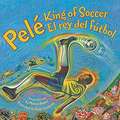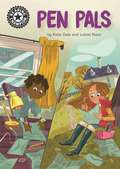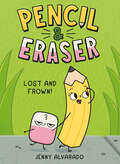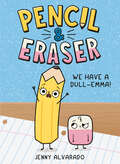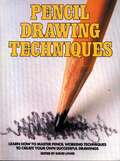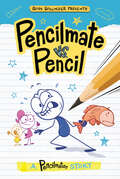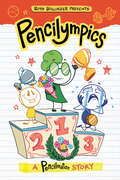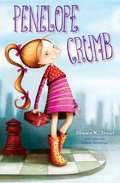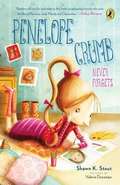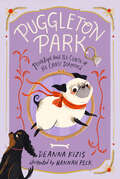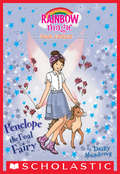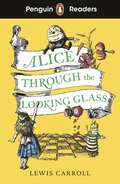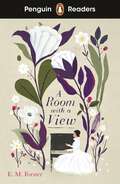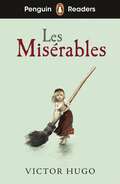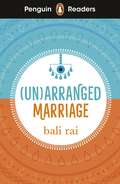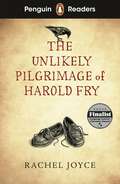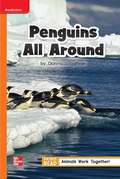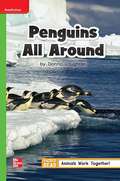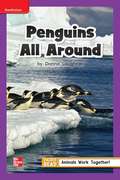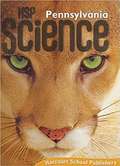- Table View
- List View
Pelé: King of Soccer / El rey del fútbol (Into Reading, Read Aloud Module 10 #2)
by Monica Brown Fernando Gayesky Rudy GutiérrezNIMAC-sourced textbook <P><P>Monica Brown and Rudy Gutierrez team up to deliver what Kirkus called, in a starred review, an “inspiring blend of art and story,” about the most famous soccer star in the world, Pelé. This bilingual picture book will inspire, teach, and amaze readers as they learn about the man who revolutionized the sport of soccer. <P><P>Do you know how a poor boy from Brazil who loved fútbol more than anything else became the biggest soccer star the world has ever known? This is the true story of Pelé, King of Soccer, the first man in the history of the sport to score a thousand goals and become a living legend. Rudy Gutierrez’s dynamic illustrations make award-winning author Monica Brown’s story of this remarkable sports hero come alive! <P><P>Lexile Measure: 730
Pen Pals: Independent Reading 16 (Reading Champion #363)
by Katie DaleRosie lives on a farm in the countryside;Jayden lives in an inner London tower block. The two becomes pen pals exchanging letters all the time. One day they decide to meet and see how different each others homes really are.This first colour chapter book is a perfectly levelled, accessible text for Key stage 2 readers aged 10-11.Reading Champion offers independent reading books for children to practise and reinforce their developing reading skills.Fantastic, original stories are accompanied by engaging artwork and activities to provoke deeper response and encourage writing. Each book has been carefully graded so that it can be matched to a child's reading ability, encouraging reading for pleasure.The Key Stage 2 Reading Champion Books are suggested for use as follows:Independent Reading 11: start of Year 3 or age 7+Independent Reading 12: end of Year 3 or age 7+Independent Reading 13: start of Year 4 or age 8+Independent Reading 14: end of Year 4 or age 8+Independent Reading 15: start of Year 5 or age 9+Independent Reading 16: end of Year 5 or age 9+Independent Reading 17: start of Year 6 or age 10+Independent Reading 18: end of Year 6 or age 10+
Pencil & Eraser: An Early Reader Graphic Novel (Pencil & Eraser)
by Jenny AlvaradoFans of NARWHAL AND JELLY as well as PIZZA AND TACO, prepare to meet your new favorite duo: a pair of best friend school supplies! In the next adventure of this hilarious early-reader graphic novel series, Pencil and Eraser get lost outside the lines!Pencil and Eraser are on their way to their first ever karate class—well, their person Stella is and they are tagging along. When Pencil gets a little too excited practicing her ninja moves, she falls right out of Stella&’s backpack and lands on the sidewalk! And naturally, Eraser has no choice but to follow her.Stranded all alone in the big wide world, these two buds will have to use their wits, charm, and of course their impressive ninja moves, to find the dojo and make it safely back into Stella&’s backpack before class is over. Between squirrelly obstacles and flashy distractions, will the duo (ahem, Pencil) stay on the straight and narrow long enough to get where they belong? Or will they be doomed to draw outside the lines for good?
Pencil & Eraser: We Have a Dull-Emma! (Pencil & Eraser #1)
by Jenny AlvaradoFans of Narwhal and Jelly & Pizza and Taco, prepare to meet your new favorite duo! This hilarious new early-reader graphic novel series follows the adventures of two best friend school supplies: Pencil and Eraser!Pencil is a joyous adventure seeker and Eraser is a cautious curmudgeon. And when their human person Stella isn&’t watching, these two unlikely friends go on all sorts of adventures!It's the start of a new school year, and Pencil and Eraser are ready for anything. Except when Pencil notices her point has dulled. That's never happened before and she feels...pointless. Stella can't write with a dull pencil. So what can Pencil do? The only answer is to leave the comfort of their desk behind and venture out to find a sharpener. But if Pencil is going on an adventure, she'll need to bring her (reluctant) bestie Eraser along for the ride. Together they'll have to traverse the classroom, scale a mountain-sized desk, enter uncharted territory of the school hallway, and avoid being caught by the janitor. Can Pencil and Eraser manage all that before Stella and her classmates return from recess?
Pencil Drawing Techniques
by David LewisHere is a really good book for the artist who wants to develop his or her pencil drawing abilities, whether it's to improve your preliminary sketch work, or to create beautiful pencil drawings complete in their own right. Pencil Drawing Techniques brings together six of today's best artists, all of whom are incredibly fine instructors as well. The artists show you how to develop your skill and ability in handling pencil technique. Ferdinand Petrie shows you how to handle pencils and produce a controlled variety of lines, values, and textures. Then he shows you exactly how to use these techniques to draw landscapes in a range of styles and compositions. Rudy De Reyna explains pencil basics, and explores perspective, size relationships, form, and structure. Douglas grave teaches you how to begin drawing portraits by building a drawing step-by-step. Norman Dams and Joe Singer demonstrate how you can use the pencil to produce spectacular drawings of animals. John Blockley and Richard Bolton show you how pencil drawings can capture the essence of a subject and help you work out a plan for painting it. Finally, Bet Borgeson teaches you all the secrets of colored pencil work and demonstrates a whole new dimension. The book is divided into seven sections: how to handle a pencil, fundamentals of drawing, drawing landscapes, drawing portraits, drawing animals, drawing for watercolors, and handling color pencils. The copious illustrations show in detail how the artists use their techniques. For the artist who uses the pencil, Pencil Drawing Techniques is an an excellent instructional book of ideas for using the pencil creatively.
Pencilmate vs. Pencil: A Pencilmation Story (Pencilmation)
by Steve BehlingPencilmate draws the line in this new chapter book. Based on the hit YouTube series Pencilmation!It's time to strike back against The Pencil in the sky! Pencilmate gathers all of his friends, Pencilmiss, Granny, and Mini Big Guy to help him find The Pencil's greatest weakness. After several sketchy moments that The Pencil draws around them, they eventually fall off the page and into a strange, new world. Our world. Who will win? Pencilmate or The Pencil? You're going to have to read and find out!
Pencilympics: A Pencilmation Story (Pencilmation)
by Jake BlackPencilmate has his eyes on the prize in this chapter book. Perfect for fans of the hit YouTube series Pencilmation!Pencilmate signs up for the Pencilympics, a competition of super athletic challenges, in order to win a quadrillion dollar prize! Follow Pencilmate as he trains and competes in an intense game of Thumb War, basketball, karate, and more! Will Pencilmate win the grand prize? Read along to find out!
Penelope Crumb
by Shawn K. StoutPenelope Crumb would LOVE Ramona Quimby! And might even name her eyebrow "Marge. "Penelope Crumb is no ordinary fourth grader. She carries around a red toolbox that used to belong to her father (who's been dead since Penelope was a baby), she keeps a list for the government chronicling the many ways in which her brother is turning into an alien, she helps her home-schooled neighbor Littie with her many projects--including the construction of a marshmallow helmet--and also, she can draw pretty much anything. So when her best friend Patsy has to draw a picture of Penelope for class, she attributes the big nose Patsy gives her to Patsy's poor art skills. But then Penelope finds out that it's true! She does have a big nose! Just like her Grandpa Felix, who's been gone from her life since before she can remember. What follows is a sweet and funny story--with tons of heart and hijinks-- about Penelope finding her grandpa and using her big nose--and his big nose--to make her family whole again. .
Penelope Crumb Never Forgets
by Shawn StoutPenelope Crumb's best friend Patsy Cline Roberta Watson is becoming best friends with another girl in class, so Penelope decides she needs to win her back. Compliments and presents fail--and Penelope is afraid she'll lose Patsy Cline forever, so she decides to swipe Patsy's necklace and start a secret museum to remember all the people she cares about, in case they leave her too. But stealing turns out not to be the best plan, when Grandpa Felix calls the police about his missing camera, forcing Penelope to confess. Now she's lost both Patsy Cline AND her museum. But in the end she makes a huge personal sacrifice to repair her friendship with Patsy and finds out that drawing pictures--what she likes to do best!--is a way to make a personal museum that doesn't involve any sort of stealing. .
Penelope and the Curse of the Canis Diamond #2 (Puggleton Park)
by Deanna KizisFollow Penelope the pug in the second book of this delightful series set in Regency-era London!Penelope the pug is completely content in her new forever home with Lady Diggleton. So when her beloved owner receives an invitation to meet the Queen at Windsor Castle—and an instruction to bring the pug along—Penelope couldn't be more pleased for her Lady's good fortune.However, once the two arrive at the castle, their fortune starts to seem less than fortunate. The Queen commands Penelope to befriend her own pup, a snooty dog named Duchess whose manners are most offensive, and who wants nothing to do with the poor pug.But when the Queen's prized Canis diamond ring goes missing and Duchess stands accused, Penelope—who knows the dog is innocent—must find a way to defend her. If the pug is certain that her fellow canine didn't commit the crime, though, can she clear Duchess's name by determining who did?
Penelope the Foal Fairy: A Rainbow Magic Book (The Farm Animal Fairies #3)
by Daisy MeadowsFarm animal antics!Rachel and Kirsty are visiting beautiful Greenfields Farm. They've been given the very special job of taking care of all the baby animals that live there. But the farm is not as peaceful as it seems . . . The ducklings are barking, the lambs are meowing, and the foals are oinking. Jack Frost has kidnapped the Farm Animal Fairies' magic animals and everything at Greenfields is all mixed up!Penelope needs Rachel and Kirsty's help to get her magic foal back. They're determined to save it from Jack Frost's icy petting zoo! Find the magic animal in each book and help save the farm magic!
Penguin Readers Level 3: Alice Through the Looking Glass
by Lewis CarrollPenguin Readers is an ELT graded reader series for learners of English as a foreign language. With carefully adapted text, new illustrations and language learning exercises, the print edition also includes instructions to access supporting material online.Titles include popular classics, exciting contemporary fiction, and thought-provoking non-fiction, introducing language learners to bestselling authors and compelling content.The eight levels of Penguin Readers follow the Common European Framework of Reference for language learning (CEFR). Exercises at the back of each Reader help language learners to practise grammar, vocabulary, and key exam skills. Before, during and after-reading questions test readers' story comprehension and develop vocabulary.Alice Through the Looking Glass, a Level 3 Reader, is A2 in the CEFR framework. The text is made up of sentences with up to three clauses, introducing first conditional, past continuous and present perfect simple for general experience. It is well supported by illustrations, which appear on most pages.Alice is playing with her kitten when she begins to feel tired. Suddenly the looking-glass moves and changes color. Alice steps through the glass into a magic world. It is even stranger than Wonderland... what might she find there?Visit the Penguin Readers websiteExclusively with the print edition, readers can unlock online resources including a digital book, audio edition, lesson plans and answer keys.
Penguin Readers Level 4: A Room with a View (ELT Graded Reader)
by E. M. ForsterPenguin Readers is an ELT graded reader series for learners of English as a foreign language. With carefully adapted text, new illustrations and language learning exercises, the print edition also includes instructions to access supporting material online.Titles include popular classics, exciting contemporary fiction, and thought-provoking non-fiction, introducing language learners to bestselling authors and compelling content.The eight levels of Penguin Readers follow the Common European Framework of Reference for language learning (CEFR). Exercises at the back of each Reader help language learners to practise grammar, vocabulary, and key exam skills. Before, during and after-reading questions test readers' story comprehension and develop vocabulary.A Room with a View, a Level 4 Reader, is A2+ in the CEFR framework. The text is made up of sentences with up to three clauses, introducing more complex uses of present perfect simple, passives, phrasal verbs and simple relative clauses. It is well supported by illustrations, which appear regularly.Lucy Honeychurch is on holiday in Florence, when she meets the strange Mr Emerson and his son, George. Feeling frightened by George's feelings for her, she soon leaves for Rome. But when the Emersons becomes her neighbours in England, Lucy must decide how she really wants to live her life.Visit the Penguin Readers websiteExclusively with the print edition, readers can unlock online resources including a digital book, audio edition, lesson plans and answer keys.
Penguin Readers Level 4: Les Misérables (ELT Graded Reader)
by Victor HugoPenguin Readers is an ELT graded reader series for learners of English as a foreign language. With carefully adapted text, new illustrations and language learning exercises, the print edition also includes instructions to access supporting material online.Titles include popular classics, exciting contemporary fiction, and thought-provoking non-fiction, introducing language learners to bestselling authors and compelling content.The eight levels of Penguin Readers follow the Common European Framework of Reference for language learning (CEFR). Exercises at the back of each Reader help language learners to practise grammar, vocabulary, and key exam skills. Before, during and after-reading questions test readers' story comprehension and develop vocabulary.Les Misérables, a Level 4 Reader, is A2+ in the CEFR framework. The text is made up of sentences with up to three clauses, introducing more complex uses of present perfect simple, passives, phrasal verbs and simple relative clauses. It is well supported by illustrations, which appear regularly.In nineteenth-century France, life was hard for many people. Victor Hugo's famous book tells the story of Jean Valjean, who spends 19 years in prison for stealing bread. When Valjean leaves prison he starts a business and tries to become a better man, but Javert the policeman will do anything to stop him.Visit the Penguin Readers websiteExclusively with the print edition, readers can unlock online resources including a digital book, audio edition, lesson plans and answer keys.
Penguin Readers Level 5: (Un)arranged Marriage (ELT Graded Reader)
by Bali RaiPenguin Readers is an ELT graded reader series for learners of English as a foreign language. With carefully adapted text, new illustrations and language learning exercises, the print edition also includes instructions to access supporting material online.Titles include popular classics, exciting contemporary fiction, and thought-provoking non-fiction, introducing language learners to bestselling authors and compelling content.The eight levels of Penguin Readers follow the Common European Framework of Reference for language learning (CEFR). Exercises at the back of each Reader help language learners to practise grammar, vocabulary, and key exam skills. Before, during and after-reading questions test readers' story comprehension and develop vocabulary.(Un)arranged Marriage, a Level 5 Reader, is B1 in the CEFR framework. The text is made up of sentences with up to four clauses, introducing present perfect continuous, past perfect, reported speech and second conditional. It is well supported by illustrations, which appear regularly.Manny lives in England with his strict Punjabi parents who are very traditional and want him to have an arranged marriage. There's just one problem: Manny definitely doesn't want an arranged marriage. With the help of his best friend, Ade, Manny makes a plan...Visit the Penguin Readers websiteExclusively with the print edition, readers can unlock online resources including a digital book, audio edition, lesson plans and answer keys.
Penguin Readers Level 5: The Unlikely Pilgrimage of Harold Fry (ELT Graded Reader)
by Rachel JoycePenguin Readers is an ELT graded reader series for learners of English as a foreign language. With carefully adapted text, new illustrations and language learning exercises, the print edition also includes instructions to access supporting material online.Titles include popular classics, exciting contemporary fiction, and thought-provoking non-fiction, introducing language learners to bestselling authors and compelling content.The eight levels of Penguin Readers follow the Common European Framework of Reference for language learning (CEFR). Exercises at the back of each Reader help language learners to practise grammar, vocabulary, and key exam skills. Before, during and after-reading questions test readers' story comprehension and develop vocabulary.The Unlikely Pilgrimage of Harold Fry, a Level 5 Reader, is B1 in the CEFR framework. The text is made up of sentences with up to four clauses, introducing present perfect continuous, past perfect, reported speech and second conditional. It is well supported by illustrations, which appear regularly.Harold Fry lives a quiet, ordinary life in England. But when he gets a phone call and learns that his old friend Queenie Hennessey is dying, he decides to post her a letter to her home 500 miles away. As he walks to the post box, Harold begins to think about his past and his family. He decides on walking until he reaches Queenie.Visit the Penguin Readers websiteExclusively with the print edition, readers can unlock online resources including a digital book, audio edition, lesson plans and answer keys.
Penguins in Antarctica: How do Penguins Live in Such a Cold Place?
by Lori O'Dea Kira FreedNIMAC-sourced textbook
